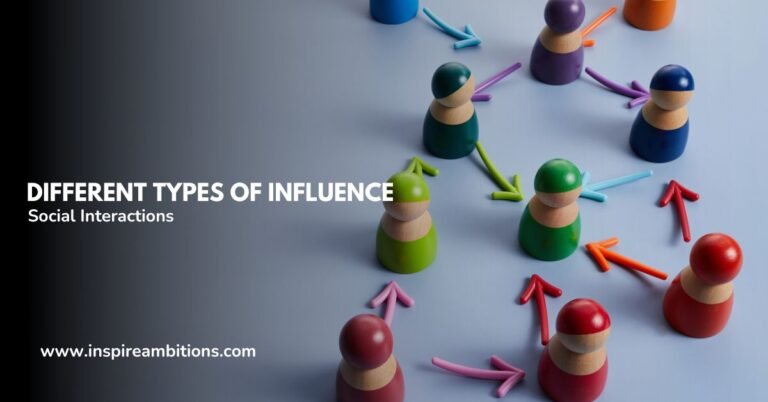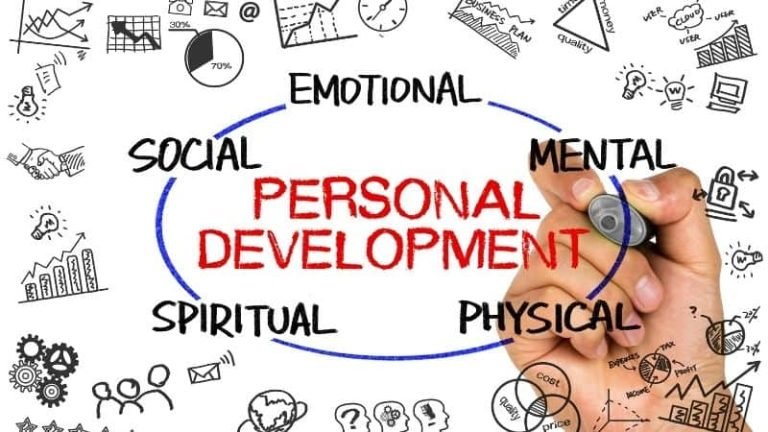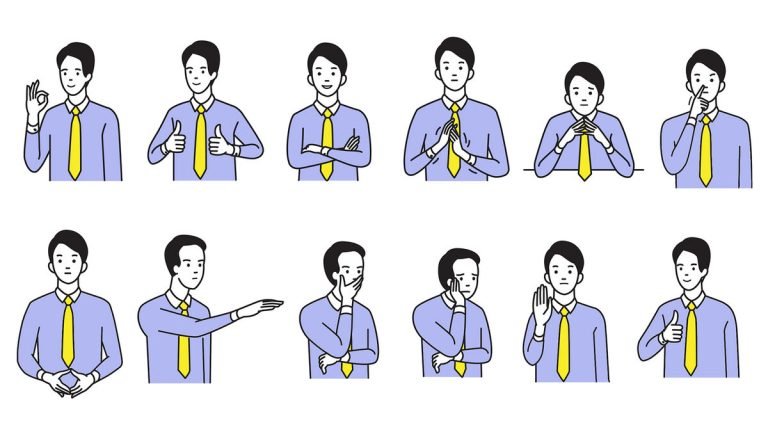Como ler a linguagem corporal? – Um guia claro e confiável
Reading body language is an essential skill that can help you understand what someone is thinking or feeling. Body language refers to the nonverbal cues people use to communicate, such as facial expressions, gestures, and posture.
Understanding body language can help you communicate more effectively and build better relationships with others.
Nonverbal communication is a significant portion of daily communication, accounting for up to 65%. By learning to read body language, you can gain valuable insights into someone’s thoughts and emotions, even when they are not speaking. For example, if someone avoids eye contact or crosses their arms, it may indicate that they are uncomfortable or defensive.
On the other hand, if someone maintains eye contact and has an open posture, it may show that they are engaged and interested in the conversation.
Learning to read body language takes practice and observation. By paying attention to people’s nonverbal cues, you can become more attuned to their thoughts and feelings.
In this article, we will explore key dicas de linguagem corporal to look out for and provide tips on interpreting them. By the end of this article, you will better understand how to read body language and use it to improve your communication skills.
How to Read Body Language? Understanding Body Language
Body language is a form of nonverbal communication that can reveal much about a person’s thoughts, feelings, and intentions. It includes gestures, posture, expressões faciais, eye contact, and body movements. Reading and interpreting body language can help you understand people better and improve your communication skills.
Basics of Body Language
Body language is an essential aspect of communication; it can convey much information that is not expressed through words. Here are some basic things to keep in mind when interpreting body language:
- Gestures: Hand movements, facial expressions, and body movements can all convey meaning. For example, crossing your arms may indicate defensiveness or closed-mindedness.
- Posture: How a person stands, or sits can reveal their confidence level, mood, or attitude. Leaning forward can indicate interest, while slouching can indicate boredom or disinterest.
- Non-verbal cues: Pay attention to the tone of voice, facial expressions, and body language to better understand what a person is saying. For example, a sarcastic comment may accompany a smirk or eye roll.
- Body movements: How a person moves their body can indicate their comfort level or discomfort in a situation. Fidgeting or shifting around may indicate anxiety or nervousness.
Science Behind Body Language
There is a lot of scientific research that goes into understanding body language. For example, studies have shown that certain facial expressions are universal and can convey the same emotions across different cultures. Other research has focused on how body language can affect our emotions and behaviour.
One theory of body language is that it is an evolutionary adaptation that helped humans communicate before language existed. Our ancestors could understand each other’s intentions and avoid danger by paying attention to nonverbal cues.
Overall, understanding body language can be valuable in improving your communication skills and building stronger relationships with others. By paying attention to nonverbal cues, you can gain a deeper understanding of what people are saying and respond in a way that is appropriate and effective.
Interpreting Facial Expressions
Understanding facial expressions is a crucial aspect of reading body language. Facial expressions can convey many emotions and intentions, and learning to interpret them correctly can help you communicate more effectively with others. Here are some key things to look for when interpreting facial expressions:
Reading Eye Behaviour
The eyes are often referred to as the “windows to the soul”, and for good reason. They can reveal a lot about a person’s thoughts and feelings. When interpreting eye behaviour, pay attention to the following:
- Eye contact: Maintaining good eye contact shows confidence and interest. However, too much eye contact can be perceived as aggressive or confrontational, while avoiding eye contact can suggest dishonesty or disinterest.
- Raised eyebrows: Raised eyebrows can indicate surprise, shock, or interest. However, if the eyebrows are raised too high, it can suggest disbelief or scepticism.
- Furrowed brow: A furrowed brow can indicate confusion, concentration, or anger. However, if the brow is furrowed too much, it can suggest frustration or annoyance.
- Eye behaviour: Rapid eye movements can indicate nervousness or anxiety, while slow, deliberate eye movements can indicate confidence or thoughtfulness.
Understanding Smiles and Frowns
Smiling and frowning are two of the most common facial expressions, and they can convey a wide range of emotions. Here are some key things to look for when interpreting smiles and frowns:
- Genuine smile: A simple smile involves both the mouth and the eyes. Look for crinkles around the eyes and a relaxed and open mouth. A genuine smile can indicate happiness, amusement, or friendliness.
- Forced smile: A forced smile involves only the mouth and can be recognised by a lack of crinkles around the eyes. A forced smile can indicate discomfort, insincerity, or even hostility.
- Frown: A frown involves a downturned mouth, and eyebrows pulled together. A frown can indicate sadness, anger, or disapproval.
By paying attention to these key indicators, you can better interpret facial expressions and read body language. Remember, however, that facial expressions can be complex and nuanced and should always be considered in the context of other nonverbal cues and verbal communication.
Decoding Gestures and Postures
Aqui está.
Gestos com as mãos
Hand gestures are a significant part of body language. They can communicate various emotions and attitudes, from confidence to nervousness. Here are some common hand gestures and what they might mean:
- Handshakes: A firm handshake indicates confidence and assertividade, while a weak handshake might suggest timidity or lack of confidence.
- Pointing: Pointing with your index finger can be aggressive or accusatory. Instead, try to use an open-hand gesture or nod in the direction you want to indicate.
- Thumb gestures: Thumbs-up is generally seen as positive and approving, while thumbs-down indicates disapproval or negativity.
Body Postures
Body postures can also provide valuable information about a person’s mind or attitude. Here are some common body postures and what they might mean:
- Open posture: Standing or sitting with a relaxed posture, such as uncrossed arms and legs, can indicate that a person is open to communication and receptive to ideas.
- Closed posture: Conversely, a closed posture, such as crossed arms or legs, can suggest defensiveness or discomfort.
- Dominant posture: Standing or sitting with a dominant stance, such as hands-on hips or chest puffed out, can indicate confidence and assertiveness.
- Arm gestures: Arm gestures can also convey various emotions and attitudes. For example, folding your arms across your chest can suggest defensiveness or discomfort, while gesturing with open palms can indicate openness and honesty.
Remember that body language is complex and nuanced, and it’s important to consider context and other factors when interpreting gestures and postures. However, attention to body language can provide valuable insights into a person’s thoughts, feelings, and attitudes.
Emotions Expressed Through Body Language
Body language can be a powerful tool to help you understand the emotions and feelings of others.
By paying attention to nonverbal cues, you can often get a better sense of what someone truly feels, even if they are not verbally expressing it. Some common emotions and body language signals are often associated with them.
Signs of Happiness and Excitement
When someone feels happy or excited, their body language is often open and relaxed. They may smile frequently, and their eyes may appear bright and engaged. Other signs of happiness and excitement include:
- Leaning forward
- Gesturing with the hands
- Standing up straight
- Nodding the head
Indicators of Sadness and Discomfort
When someone feels sad or uncomfortable, their body language may be closed off and defensive. They may avoid eye contact, hunch their shoulders, or cross their arms over their chest. Other signs of sadness and discomfort include:
- Frowning or looking down
- Speaking softly or hesitantly
- Avoiding physical contact
- Slouching or appearing tense
Signals of Anger and Disapproval
When someone feels angry or disapproving, their body language may be tense and aggressive. They may stand with their feet apart, clench their fists, or raise their voice. Other signs of anger and disapproval include:
- Scowling or glaring
- Pointing or shaking a finger
- Interrupting or talking over others
- Invading personal space
By paying attention to these body language signals, you can better understand the emotions and feelings of those around you. However, it is essential to remember that body language can be misleading, and it is always best to confirm your observations with verbal communication.
Linguagem Corporal em Diferentes Contextos
Body language is an essential aspect of communication that can reveal much about a person’s thoughts, feelings, and intentions. Understanding how to read body language in different contexts is necessary to interpret it accurately. This section will discuss body language in personal relationships and professional settings.
Nas relações pessoais
Body language is crucial in conveying emotions and building trust in personal relationships. Positive body language signals like eye contact, open posture, and smiling can indicate interest, attraction, and warmth. On the other hand, negative body language signals like crossed arms, avoiding eye contact, and frowning can show distrust, disinterest, or discomfort.
Touch is also an essential aspect of body language in personal relationships. Touch can convey a range of emotions, from affection to aggression. Appropriate touch can build trust and intimacy, while inappropriate touch can cause discomfort and distrust.
However, it is essential to note that body language can be misinterpreted in personal relationships. For example, a person may avoid eye contact due to shyness or anxiety, not because they are being dishonest. Therefore, it is essential to consider the context and other verbal cues when interpreting body language in personal relationships.
In Professional Settings
In professional settings, body language can influence communication and establish trustworthiness. Positive body language signals like good posture, firm handshake, and maintaining eye contact can convey confidence, competence, and reliability. Negative body language signals like slouching, weak handshakes, and avoiding eye contact can mean a lack of trust, incompetence, and distrust.
However, it is essential to maintain appropriate boundaries when using touch in professional settings. Inappropriate touch can be perceived as harassment or aggression and damage professional relationships.
It is also important to note that body language can be used to deceive in professional settings. For example, a person may maintain good posture and eye contact while lying. Therefore, it is essential to consider other verbal and nonverbal cues when interpreting body language in professional settings.
Understanding body language in different contexts can help you interpret it accurately and establish trust in personal and professional relationships.
Detecting Deception and Insecurity
When reading body language, detecting deception and insecurity can be tricky. However, some specific nonverbal signals and cues can tell you whether someone is lying or feeling insecure.
Signs of Deception
If you suspect someone is lying, pay attention to the following nonverbal signals:
- Lack of eye contact or avoiding eye contact
- Covering the mouth or touching the face
- Fidgeting or restlessness
- Inconsistent body language, such as crossed arms and legs
- Microexpressions, such as a quick flash of anger or fear
Remember that these signals alone do not necessarily mean someone is lying, but they can be indicators of deception. It’s essential to look for clusters of nonverbal cues and consider the context of the situation.
Indicators of Insecurity
Insecurity can also be conveyed through body language. Look for the following nonverbal cues:
- Hunching or slouching
- Avoiding eye contact
- Fidgeting or playing with objects
- Nervous laughter or excessive smiling
- Covering the body with crossed arms or legs
If you notice these signals, it’s essential to approach the situation with empathy and understanding. Insecurity can stem from various factors, and sensitivity to the individual’s feelings is necessary.
In conclusion, detecting deception and insecurity through body language requires careful observation and interpretation of nonverbal signals and cues. While these signals can help understand a person’s emotional state, it’s essential to consider the context and approach the situation with empathy and understanding.
Cultural Differences in Body Language
Body language is a universal form of communication that people can understand worldwide. However, cultural differences can significantly affect how body language is interpreted. Awareness of these differences is essential to avoid misunderstandings and comunicar efetivamente.
For instance, a thumbs up is a sign of approval or agreement in Western cultures. However, it is considered an obscene gesture in some Middle Eastern and African cultures. Similarly, a thumbs down in Western cultures means disapproval or rejection, but in parts of West Africa, it is a sign of respect.
Silence is another aspect of body language that varies across cultures. In Western cultures, silence is often viewed as unfavourable, indicating disinterest or inattentiveness. However, in some Asian cultures, silence can signify respect or agreement. In some Native American cultures, silence is valued to show respect and contemplation.
In some cultures, direct eye contact is seen as a sign of respect and attentiveness; in others, it can be seen as aggressive or disrespectful. In Japan, for example, prolonged eye contact is often avoided to show respect and humility.
It is also essential to be aware of cultural norms around physical touch. In some cultures, such as Latin America or the Middle East, physical contact is typical and even expected in social situations. In other cultures, such as East Asia, physical touch is less common and can be seen as intrusive or inappropriate.
Overall, being aware of cultural differences in body language is essential for effective communication and avoiding misunderstandings. By understanding these differences, you can adjust your body language and interpret the body language of others more accurately.
Improving Your Body Language Reading Skills
To improve at reading body language, you need to practice regularly and gain experience interpreting nonverbal cues. Here are some tips to help you improve your body language reading skills:
- Observe Baseline Behaviour
You must establish baseline behaviour before accurately reading someone’s body language. This is their normal behaviour when they are not experiencing any strong emotions. By observing their baseline behaviour, you can better understand their body language when they do display nonverbal cues.
- Pay Attention to Context
Body language can be influenced by the context in which it is displayed. For example, someone may show different body language in a professional versus social environment. Pay attention to the context in which the body language is said to understand its meaning better.
- Look for Clusters of Behaviour
One nonverbal cue on its own may not mean much, but when you observe clusters of behaviour, you can better understand what someone is feeling or thinking. For example, someone crossing their arms, avoiding eye contact, and frowning may feel defensive or uncomfortable.
- Consider the Whole Person
When you read body language, it’s essential to consider the whole person, not just individual cues. For example, if someone is smiling, but their eyes are not crinkled, they may be faking their smile. By considering the whole person, you can better understand their genuine emotions.
- Practice Active Listening
Active listening is a critical component of reading body language. You can better understand their nonverbal cues by actively listening to what someone is saying. For example, suppose someone says they are happy, but their body language indicates otherwise. In that case, you can ask them follow-up questions to understand their genuine emotions better.
By following these tips, you can improve your body language reading skills and become better at decoding nonverbal cues.






